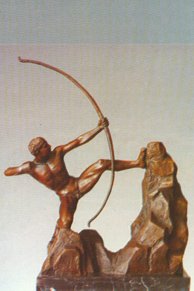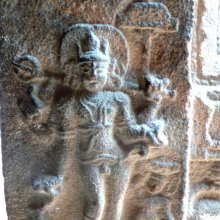Pinaka, Piṅāka, Pināka, Pinākā: 17 definitions
Introduction:
Pinaka means something in Hinduism, Sanskrit, Hindi. If you want to know the exact meaning, history, etymology or English translation of this term then check out the descriptions on this page. Add your comment or reference to a book if you want to contribute to this summary article.
Alternative spellings of this word include Pinak.
Images (photo gallery)
In Hinduism
Purana and Itihasa (epic history)
Source: archive.org: Puranic EncyclopediaPināka (पिनाक).—The bow of Śiva. Pīnāka was formerly the three-forked spike of Śiva. Once it fell down from the hands of Śiva and on falling down took the shape of a bow. From then onwards it was used as a bow. See under Pāśupata. (Chapter 38. Sabhā Parva: Chapter 141, Anuśāsana Parva; Chapter 289. Śānti Parva).
Source: archive.org: Shiva Purana - English TranslationPināka (पिनाक) refers to Śiva’s Bow, according to the Śivapurāṇa 2.4.16 (“The head of Gaṇeśa is chopped off”).—Accordingly, as Brahmā narrated to Nārada: “[...] Gaṇeśa, the great hero, who had been rendered more powerful by Pārvatī and the Śaktis remembered the lotuslike feet of his mother and struck [Śiva] in his hand with his Śakti. Thereupon the trident fell from the hand of Śiva of supreme soul. Seeing this, Śiva the source of great enjoyment and protection took up his bow Pināka. Gaṇeśa felled that to the ground by means of his iron club. Five of his hands too were struck. He took up the trident with the other five hands. [...]”.
Source: Cologne Digital Sanskrit Dictionaries: The Purana IndexPiṅāka (पिङाक).—The bow of Śiva; hence Śiva is Pināki.*
- * Vāyu-purāṇa 25. 2; 54. 108; 101. 317.

The Purana (पुराण, purāṇas) refers to Sanskrit literature preserving ancient India’s vast cultural history, including historical legends, religious ceremonies, various arts and sciences. The eighteen mahapuranas total over 400,000 shlokas (metrical couplets) and date to at least several centuries BCE.
Dhanurveda (science of warfare)
Source: Wisdom Library: DhanurvedaPināka (पिनाक) refers to a weapon (a staff or bow of Rudra-Śiva). It is a Sanskrit word defined in the Dhanurveda-saṃhitā, which contains a list of no less than 117 weapons. The Dhanurveda-saṃhitā is said to have been composed by the sage Vasiṣṭha, who in turn transmitted it trough a tradition of sages, which can eventually be traced to Śiva and Brahmā.

Dhanurveda (धनुर्वेद) refers to the “knowledge of warfare” and, as an upaveda, is associated with the Ṛgveda. It contains instructions on warfare, archery and ancient Indian martial arts, dating back to the 2nd-3rd millennium BCE.
Shaktism (Shakta philosophy)
Source: Kamakoti Mandali: Nrisimha matrika-mandalaPinākā (पिनाका) refers to one of the various Mātṛkā-Śaktis created by Rudra in order to destroy the clones that spawned from Andhaka’s body.—Accordingly, [...] Andhakāsura attempted to abduct Girājanandinī (Pārvatī) and thus ensued a fierce battle between Andhakāsura and the great Rudra, the Lord of Umā. Like raktabīja, every drop of blood that fell from the body of Andhaka created another Asura like him and in no time, the entire world was filled with Andhakas. To destroy the growing number of Andhakas, Rudra created innumerable Mātṛkā-Śaktis [viz., Pinākā]. These Śaktis of immense power at once began to drink every drop of blood that flowed from the body of Andhaka, but they could still not effectively contain the emergence of more and more demons.

Shakta (शाक्त, śākta) or Shaktism (śāktism) represents a tradition of Hinduism where the Goddess (Devi) is revered and worshipped. Shakta literature includes a range of scriptures, including various Agamas and Tantras, although its roots may be traced back to the Vedas.
General definition (in Hinduism)
Source: Hindupedia: HinduismPināka (पिनाक).—Though Śiva has the triśula as the distinguishing weapon, he also has a bow called ‘pināka’ which he uses occasionally as in the destruction of Tripura or the three cities of the demons and the sons of Tārakāsura like Tārākṣa. According to one version, Śiva’s trident once fell down and got bent into the shape of a bow. This came to be known as the pināka. Pāśupata is the chief arrow that is discharged from this bow. The word is sometimes defined as ‘that which protects’ people from evil forces.
Languages of India and abroad
Sanskrit dictionary
Source: DDSA: The practical Sanskrit-English dictionaryPināka (पिनाक).—[pā rakṣaṇe ākan nuṭ dhātorāta itvam Uṇādi-sūtra 4. 15.]
1) The bow of Śiva; निपपात जवादिषुः पिनाकान् महतोऽ भ्रादिव वैद्युतः कृशानुः (nipapāta javādiṣuḥ pinākān mahato' bhrādiva vaidyutaḥ kṛśānuḥ) Kirātārjunīya 13.2.
2) A trident; 'पिनाकोऽस्त्री रुद्रचापे पांशुवर्षत्रिशूलयोः (pināko'strī rudracāpe pāṃśuvarṣatriśūlayoḥ)' Medinī.
3) A bow in gneral.
4) A staff or stick.
5) A shower of dust.
Derivable forms: pinākaḥ (पिनाकः), pinākam (पिनाकम्).
Source: Cologne Digital Sanskrit Dictionaries: Shabda-Sagara Sanskrit-English DictionaryPināka (पिनाक).—mn.
(-kaḥ-kaṃ) 1. The bow of Siva. 2. A trident or three-pronged spear. 3. The trident of Siva. 4. A shower of dust. f. (-kī) A musical instrument, a sort of viol. E. pā to preserve, (the world,) Unadi aff. ākan, the radical vowel changed to i, and num augment.
Source: Cologne Digital Sanskrit Dictionaries: Benfey Sanskrit-English DictionaryPināka (पिनाक).—m. and n. 1. A staff, Mahābhārata 5, 5259. 2. The bow of Śiva, 13, 849. 3. The club of Śiva, 6, 2797.
Source: Cologne Digital Sanskrit Dictionaries: Cappeller Sanskrit-English DictionaryPināka (पिनाक).—[neuter] staff, stick; the club and the bow of Rudra-Śiva.
Source: Cologne Digital Sanskrit Dictionaries: Monier-Williams Sanskrit-English Dictionary1) Pināka (पिनाक):—m. n. a staff or bow, ([especially]) the staff or bow of Rudra-Śiva, [Atharva-veda; Vājasaneyi-saṃhitā; Taittirīya-saṃhitā; Mahābhārata] etc.
2) Śiva’s trident or three-pronged spear (= śūla and tri-śūla), [cf. Lexicographers, esp. such as amarasiṃha, halāyudha, hemacandra, etc.]
3) falling dust, [cf. Lexicographers, esp. such as amarasiṃha, halāyudha, hemacandra, etc.]
4) n. a species of talc, [Bhāvaprakāśa] (Perhaps [from] pi-api-√nam; cf. nāka.)
Source: Cologne Digital Sanskrit Dictionaries: Yates Sanskrit-English DictionaryPināka (पिनाक):—[(kaḥ-kaṃ)] 1. m. n. The bow of Shiva; his trident; shower of dust. f. (kī) A sort of viol.
Source: DDSA: Paia-sadda-mahannavo; a comprehensive Prakrit Hindi dictionary (S)Pināka (पिनाक) in the Sanskrit language is related to the Prakrit word: Piṇāga.
[Sanskrit to German]
Sanskrit, also spelled संस्कृतम् (saṃskṛtam), is an ancient language of India commonly seen as the grandmother of the Indo-European language family (even English!). Closely allied with Prakrit and Pali, Sanskrit is more exhaustive in both grammar and terms and has the most extensive collection of literature in the world, greatly surpassing its sister-languages Greek and Latin.
Hindi dictionary
Source: DDSA: A practical Hindi-English dictionary1) Pinaka (पिनक) [Also spelled pinak]:—(nf) lethargy reinforced by drowsiness caused by opium intoxication; —[meṃ ānā] to be drowsy due to opium intoxication; —[savāra honā] to stagger like a drunken man, to behave like an opium intoxicated person.
2) Pināka (पिनाक) [Also spelled pinak]:—(nm) the mighty mythological bow of Lord Shiv.
3) Pīnaka (पीनक) [Also spelled pinak]:—(nf) see [pinaka].
...
Kannada-English dictionary
Source: Alar: Kannada-English corpusPināka (ಪಿನಾಕ):—
1) [noun] the three pronged weapon of Śiva.
2) [noun] the bow of Śiva.
Kannada is a Dravidian language (as opposed to the Indo-European language family) mainly spoken in the southwestern region of India.
See also (Relevant definitions)
Starts with: Pinakabhra, Pinakabhrit, Pinakadhrik, Pinakadhrit, Pinakagoptri, Pinakahasta, Pinakai, Pinakakudmant, Pinakakunmat, Pinakam, Pinakana, Pinakapani, Pinakasena, Pinakavasa.
Ends with: Supinaka.
Full-text (+40): Pinakapani, Pinakin, Painaka, Pinakabhrit, Pinakagoptri, Pinakadhrik, Pinaki, Pinakasena, Pinakahasta, Pinaga, Pinakavasa, Pinakinimahatmya, Pinakidish, Pinakini, Pinak, Abhraka, Pinakam, Varapanin, Pinakadhrit, Aropa.
Relevant text
Search found 34 books and stories containing Pinaka, Piṅāka, Pināka, Pinākā, Pīnaka; (plurals include: Pinakas, Piṅākas, Pinākas, Pinākās, Pīnakas). You can also click to the full overview containing English textual excerpts. Below are direct links for the most relevant articles:
Rudra-Shiva concept (Study) (by Maumita Bhattacharjee)
2. Vājasaneyi-saṃhitā (b): Rudra’s weapons < [Chapter 2 - Rudra-Śiva in the Saṃhitā Literature]
2.15. Rudra as Pinākapāṇi < [Chapter 6a - The Epithets of Rudra-Śiva]
2.13. Rudra as Kṛttivāsa < [Chapter 6a - The Epithets of Rudra-Śiva]
The Skanda Purana (by G. V. Tagare)
Chapter 28 - The Lord Adopts the Form of Nṛsiṃha < [Section 2 - Puruṣottama-kṣetra-māhātmya]
Chapter 94 - The Greatness of Nandikeśvara (nandika-īśvara-tīrtha) < [Section 3 - Revā-khaṇḍa]
Chapter 229 - Birth of Bhṛṅgīriṭi < [Section 1 - Tīrtha-māhātmya]
Sahitya-kaumudi by Baladeva Vidyabhushana (by Gaurapada Dāsa)
Text 11.40 [Parikarāṅkura] < [Chapter 11 - Additional Ornaments]
Nitiprakasika (Critical Analysis) (by S. Anusha)
Pināka (Trident) < [Chapter 3]
Sarga V: Amuktāyudha-nirūpaṇa (51 Verses) < [Chapter 2]
Sarga II: Dhanurveda-viveka-kathana (64 Verses) < [Chapter 2]
Garga Samhita (English) (by Danavir Goswami)
Verse 8.13.88 < [Chapter 13 - A Thousand Names of Lord Balarāma]
Hanuman Nataka (critical study) (by Nurima Yeasmin)
9.2. The character of Lakṣmaṇa < [Chapter 4]
Related products

